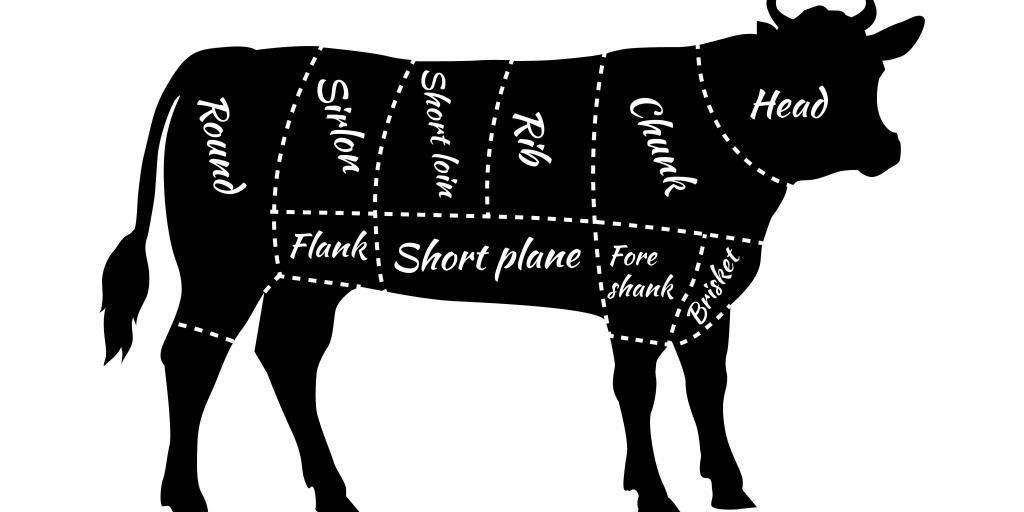Vast improvements and efficiencies notwithstanding, meat processing and packaging remains largely unchanged since Philip Armour invented the “disassembly line” during the industrial revolution. According to the Oklahoma Department of Agriculture, Food and Forestry, a steer that weighs 1,000 pounds “on the hoof ” will weigh, roughly, 610 pounds after it’s dressed (head, hide, hooves and organs removed), and it will yield about 430 pounds of meat once it’s divided into these nine sections or “primals”:
BRISKET
A relatively small section of boneless beef taken from the cow’s pectoral muscle, the brisket can take many forms. Texans smoke it over hardwood for Texas-style barbeque. Farther north in Kansas City barbeque pits, it’s smoked twice to make burnt ends. The Irish turned it into corned beef by curing it with a salty brine. “Brisket is a cross-cultural wonder—a Jewish dish cooked in a Dutch oven with Sicilian sauce served in North Dakota,” says Stephanie Pierson in The Brisket Book: A Love Story with Recipes (Andrews McMeel, 2011).
CHUCK
This is the largest section of the cow after the initial stage of processing. A 1,000-pound steer will yield about 108 pounds of chuck meat. Located near the neck and shoulder bones, chuck meat contains a lot of connective tissue that melts during cooking, and it is one of the less-tender portions. These cuts are best for braising and broiling—in other words, slow-cooking.
SHANK
The shank is the smallest of the nine sections, weighing in at about 17 pounds for a 1,000-pound steer, and it comes from the top of the cow’s front leg. Because this muscle is heavily used during the cow’s life, it tends to be very lean and tough, making it ideal for lean ground beef as well as long-cook-time preparations, such as stew or beef bourguignon.
RIB
In addition to the familiar back ribs, the ribeye is the best-known and one of the most prized cuts, whether in steak or roast form. “My favorite cut of beef is a bone-in rib-eye steak, and many people in the meat industry would make the same choice,” says Craig Bolton, a meat and seafood specialist with King Soopers.
PLATE
This small section that comes from the cow’s lower chest/upper belly produces tough, fatty meat that’s cut into skirt steak, hangar steak—so named because it hangs from the diaphragm—short ribs and ground beef. Salt-brining and smoking the plate makes New Yorkers’ favorite deli meat: pastrami.
FLANK
Like the brisket and plate, the flank comes from the cow’s underbelly, specifically the lower abdominal. Cattle don’t do a lot of crunches while grazing in the pastures, but this is still a heavily used muscle, so the meat tends to be tough. The flank is used to make London broil and other dishes that call for long, slow and moist cooking methods.
LOIN
Just like the center of our back, this section does very little work during a cow’s life, so the loin tends to be extremely tender but also quite lean. Because of their location, size, quality and quantity, the tenderloin and filet from this section are always the most expensive. “Tenderloin costs are driven by supply and demand, and demand consistently exceeds supply,” says Bolton. “Restaurants compete with retailers for the more expensive cuts, which drives the costs even higher.”
SIRLOIN
Further subdivided into the top sirloin and bottom sirloin, this medium section yields some of the most highly prized cuts. A package of ground beef might contain meat from several sections of the cow, while ground sirloin only contains meat from this section and is usually very lean.
ROUND
A more delicate name for “butt” or “rump,” the round is the second-largest of the nine sections. Also a heavily used zone during the cow’s life, the rump muscle is lean and tough, so round roasts and steaks should be tenderized before being cooked.
More about beef:
BEEF: Meat Your Match: How much and what’s the grade?
BEEF: What the Cut: The five major categories of cuts

